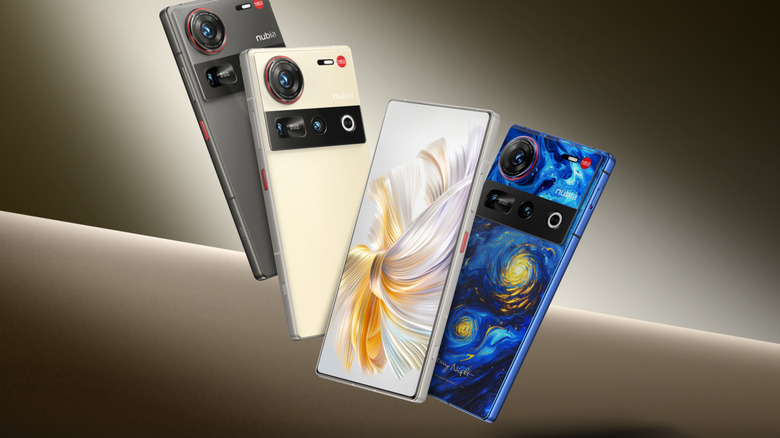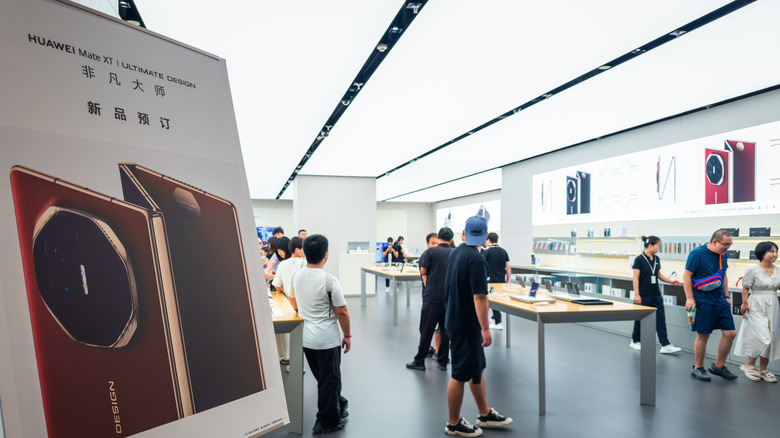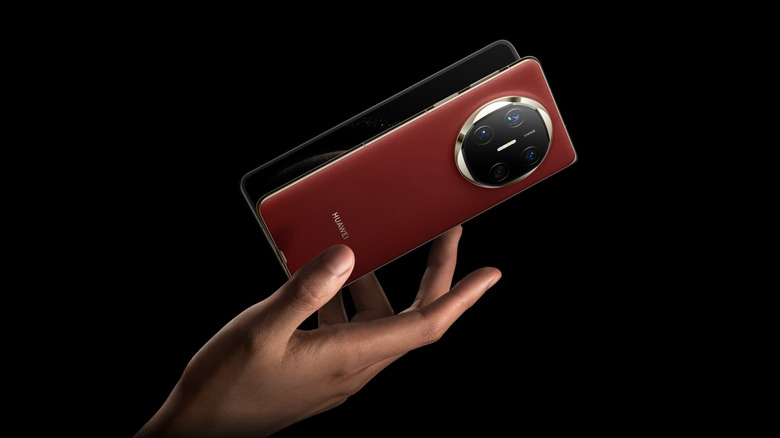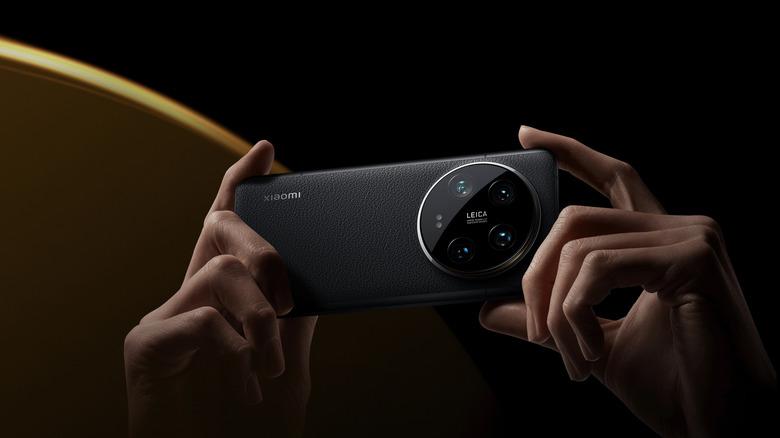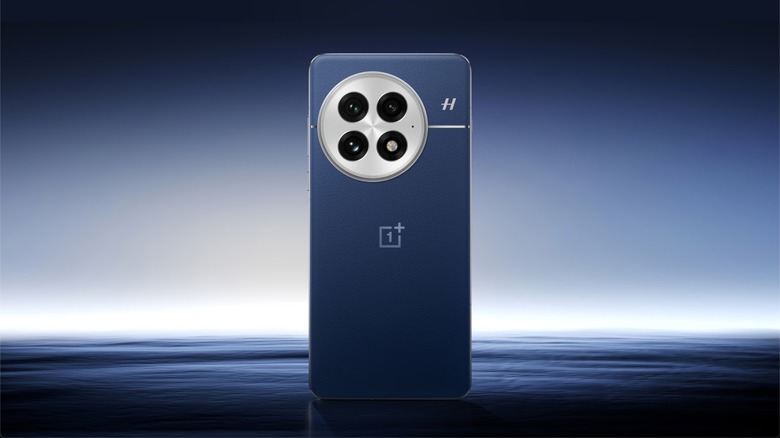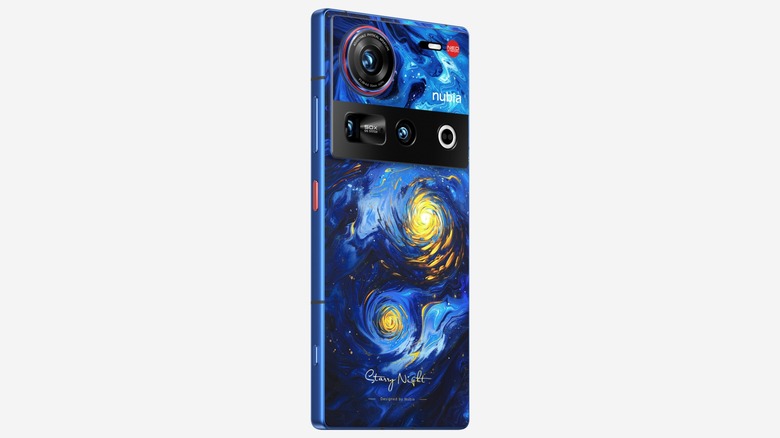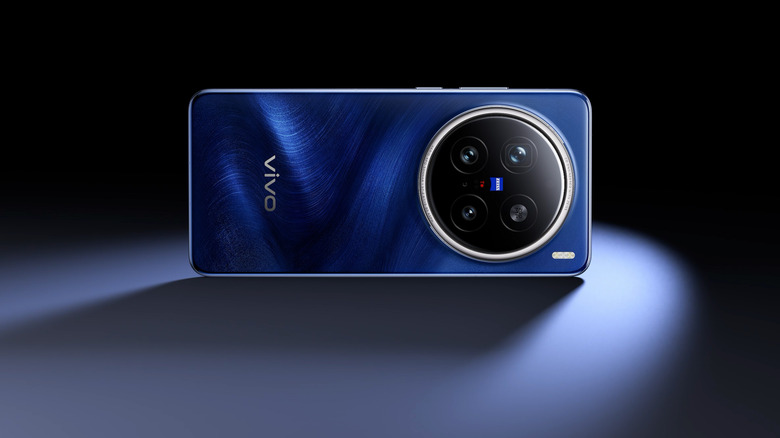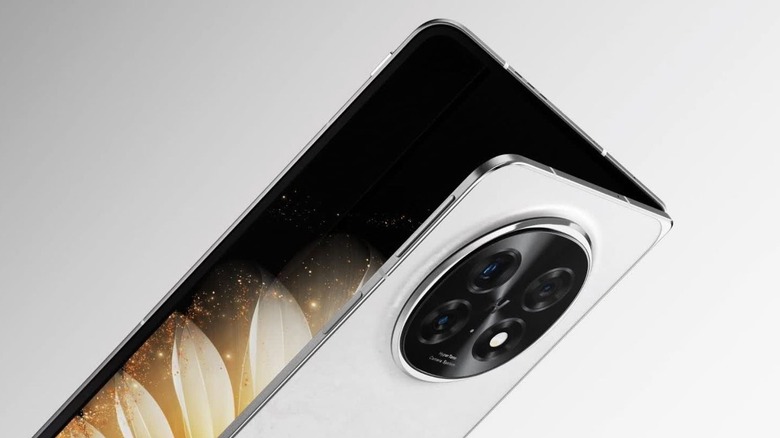6 Of The Best Phones The U.S. Is Missing Out On
We may receive a commission on purchases made from links.
Americans are internationally known for a tendency to ignore much of what occurs beyond their borders, and that extends to technology. While many of the largest tech companies in the world are quartered here, there are plenty of exciting developments happening around the world. Smartphones are a prime example. Apple may have kicked off the mobile era with the original iPhone, but foreign companies are pushing forward with some of today's most exciting cell phone innovations. From blazing fast charging speeds to triple-folding phones, the United States is missing out on some of the coolest smartphones. There are a variety of reasons for that, which we'll cover briefly below, but it's safe to say the American smartphone market has limited options compared to elsewhere in the world.
The U.S. smartphone market is overwhelmingly dominated by the Apple-Samsung duopoly. It's a stark contrast from just a decade ago, when they faced strong competition from the likes of HTC, LG, and more, not to mention from alternative operating systems like the long-defunct Windows Phone. Today, there's still a healthy smartphone ecosystem elsewhere in the world, but U.S. residents have to proactively seek those options out. Some phones aren't sold in the States due to legal snafus, others due to the market. Whatever the reason, you can't just walk into a store and buy them. If a phone isn't made by Apple, Google, Samsung, Motorola, or a few other select brands, you probably can't buy it at your carrier's store, or even at a big box store like Best Buy or Walmart. Instead, you'll need to buy it online, in many cases having it shipped from overseas.
Why are some phones hard to get in the United States?
America's trade issues with China have been escalating. One effect of those tensions has been the increasing willingness of the U.S. to deploy isolationist trade policies like chip sales bans that have the effect of artificially insulating American companies from the burden of competition with Chinese firms. The stated rationale behind a number of these bans has been national security — most recently invoked to justify the law banning TikTok in lieu of a sale by its Chinese parent company. Whatever the merit of those concerns, one effect is fewer choices for American consumers. There are other reasons Americans are missing out on the coolest smartphones. For example, stores and carriers don't see a market for phones most people haven't heard of.
While phones from companies like Huawei, ZTE, and others are not sold by carriers or shops here in the States, you can still technically get your hands on them. You just might have to find an importer or look on websites you've never considered for some phones. Others are available from mainstream retailers like Amazon. However, even once you have the device in hand, some phones won't work on some American networks, and in those cases you won't even be able to use the Google Play Store to install apps due to a lack of Google Play Services. However, as I write, the Trump administration is abruptly halting shipment of most commercial packages from China. In addition to items from Shein and Temu, Chinese smartphones may not be allowed into the country. It's unclear how smartphones will be affected by evolving rules, as well as how long they will last. In any case, let's salivate over some sweet smartphones.
Huawei Mate X6
If you're a U.S.ww resident who wants a folding phone, your options will mostly be limited to Samsung, Google, Motorola, or OnePlus if you venture away from carrier shelves. But the Huawei Mate 6 gives those brands a run for their money with its incredibly thin form factor and high-end flagship specs. Unfolded, it clocks in at 4.6 mm thin, even slimmer than the remarkably thin M4 iPad Pro or Galaxy Z Fold6.
Thanks to restrictions on its chip supply, Huawei equipped the Mate X6 with the Kirin 9020 chipset. While it's based on a 7 nm process, lagging behind the latest mobile processors from Qualcomm, the 9020 performs about as well as Qualcomm chips like the Snapdragon 8 Gen 1 from 2022 in multi-core scenarios. A bigger highlight is the folding display, which is a beautiful 7.93 inch OLED panel running at 120 Hz with a 2440 x 2240 pixel resolution, or 417 pixels per-inch (PPI). It has a robust camera system consisting of a 50 MP wide lens, a 40 MP ultra-wide, and a 48 MP telephoto lens.
For software, the Mate X6 runs Huawei's custom version of Android, EMUI. Reviewers have praised its eye-candy design, great multitasking features, and more, but have noted its underpowered chip and difficulty running Google Play Services (another result of American restrictions). Due to the headaches, some reviewers have cautioned against buying it despite its otherwise lovely package.
Xiaomi 14 Ultra
You can think of Xiaomi as a younger, hipper, Samsung. The company was founded in Beijing, China in 2010 and had garnered the lion's share of smartphone sales in China by 2014, surpassing even Samsung. This was achieved by continually putting out smartphones that won over consumers with features, performance, and bargain bin prices. The latest flagship phone from this upstart giant is the Xiaomi 14 Ultra (although a new model is probably coming along soon, as it was released in February of last year).
Running on the Qualcomm Snapdragon 8 Gen 3 platform, which also powered the Samsung Galaxy S24 Ultra last year, the 14 Ultra is a phone that knows it has stiff competition. It one-ups even Samsung's brand-new S25 Ultra by including 16 GB of RAM, then piles on the pressure with a WQHD+, 6.73 inch, AMOLED, adaptive refresh rate panel that reaches 120 Hz using LTPO technology. The 14 Ultra's camera array, a massive, black obelisk that dominates the backside of the device, is a collaboration with renowned German camera company Leica. It consists of a 50-megapixel main camera with a 1-inch sensor, a 50-megapixel floating telephoto camera, a 50-megapixel, 120mm periscope camera, and a 50-megapixel, 12mm ultra-wide camera. Leica color science and special modes such as Supermoon (it takes pictures of the moon, unsurprisingly) round out the kit on the software side.
That's a whole lot of phone for just north of $1,000, undercutting Samsung's Ultra line by a few hundred dollars. It's been widely praised by reviewers, especially for its excellent cameras. But to get your hands on it, you'll have to hit up Amazon or another online retailer.
OnePlus 13
Chinese smartphone brand OnePlus started out in pursuit of what was often called the "flagship killer," a phone that could undercut on price and overdeliver compared to the most impressive offerings from more mainstream brands. And it delivered. It might be partially the fault of the OnePlus 13 that Samsung caught flak for its perceived lack of meaningful updates to this year's S25 Ultra. It has several futuristic features that aren't yet found in flagships from Apple, Google, or Samsung. Firstly, it uses a 6,000 mAh silicon carbon battery with up to 100-watt wired charging and 50-watt wireless charging, meaning its wireless charging is faster than Samsung or Apple's fastest wired charging. Second, it has a display that touts 4,500 nits of peak brightness, more than double the latest iPhone 16 Pro Max's peak and almost double that of the Galaxy S25 Ultra. It matches the latter device's processor — both use the blazing fast Qualcomm Snapdragon X Elite chip — and absolutely blows it away when it comes to memory with a whopping 24 GB of RAM compared to the S25 Ultra's 12 GB.
OnePlus worked with Hasselblad, best known for making the cameras used to film the first moon landing, to create the 13's camera. The main lens houses a 50 megapixel Sony sensor clocking in at 1/1.14" in size, accompanied by two more 50 megapixel shooters for the telephoto and ultrawide cameras. The phone received rave reviews, with SlashGear's Adam Doud awarding it our Editor's Choice and calling it the phone to beat in 2025. Unfortunately, carrier support is limited in the US, so even though it's easier to get the OnePlus 13 than some other Chinese phones, you might be out of luck if you want to actually use it.
ZTE nubia Z70 Ultra
ZTE was one of two companies directly hit with U.S. restrictions, along with Huawei. The resulting tête-à-tête has been a headache-inducing game of economic ping poing. Suffice to say the situationdd remains complicated and ZTE does not sell directly in the United States. To skirt the rules, ZTE spun off its Nubia brand as a subsidiary, so determined Americans can get their hands on the company's latest flagship, the ZTE nubia Z70 Ultra.
Like other current generation import phones, specs are excellent on the Z70 Ultra. The latest Snapdragon X Elite chip powers the handset, backed up by up to a whopping 24 GB of RAM at a time when Samsung still sticks with 12 GB on the same processor and Apple is still content with 8 GB. The display is a 1216 x 2688 AMOLED, 144 Hz panel that measures 6.85 inches and reaches 2,000 nits of peak brightness. The triple camera array consists of a 50 megapixel wide main, 64 megapixel telephoto, and 50 megapixel ultrawide shooters. Impressively, the Z70 Ultra also has an IP69 water and dust resistance rating, meaning it can survive even very hot water jets, or movement underwater.
But what really makes the nubia Z70 Ultra tantalizing is its design. It's boxy and squared off in a confident way, and it comes in a "Starry Night" variant that echoes the famous Van Gogh painting with an artistic, textured backplate. Pulling this phone out of your pocket in public is sure to attract attention. Unfortunately, North American support is limited, and we saw at least one disappointed Amazon customer who had to return the ZTE nubia Z70 Ultra after being unable to activate it with their wireless carrier.
Vivo X200 Pro
Some phones on this list are easier to get in the United States than others, but Vivo hasn't properly launched a US variant of its latest flagship, the X200 Pro, as of this writing. However, reviewers who were able to get their hands on one have broadly praised the device for its excellent camera, durability, and design. That camera does indeed appear impressive, starting with the 200 megapixel periscope telephoto lens that can extend up to 3.7 times optical zoom for high resolution shots of far-off subjects. It's accompanied by two 50 megapixel wide and ultrawide shooters.
As for the platform, the Vivo X200 Pro packs a Mediatek Dimensity 9400 processor, a 3 nanometer process that competes against the latest Snapdragon X Elite chip from Qualcomm. It's accompanied by up to 16 gigabytes of RAM, which feels like a great time to remind you yet again that Samsung only stuck 12 gigabytes in the Galaxy S25 Ultra and Apple is resting on its laurels with 8 gigabytes in the iPhone 16 Pro Max. Another spec that blows them both away is the battery, which is a whopping 6,000 mAh on the global version. The X200 Pro also carries an IP69 water and dust resistance rating to protect it even from jets of hot water. Again, neither Apple nor Samsung have reached that level of protection on their flagships.
Oppo Find N5
The parent brand to OnePlus, Oppo made waves with its upcoming Find N5 foldable phone by claiming the title of thinnest foldable yet. Indeed, renders displayed on Oppo's website show that the device is barely thinner than its USB-C port when unfolded. Unfortunately, getting your hands on one in the United States after it launches on February 20th will prove difficult. Oppo has no retail partners stateside, so you'll have to hunt around online.
What we know about this device ahead of its launch is that its camera system was created in partnership with Hasselblad (the same collaboration that goes into the cameras on OnePlus devices). It will be composed of two 50 megapixel wide and periscope telephoto shooters, along with a head-scratchingly low-resolution 8 megapixel ultrawide. It will run on the blazing fast Qualcomm Snapdragon X Elite chip, the cream of the current Android crop, which will be accompanied by 16 gigabytes of RAM. Like other Chinese market phones this cycle, it will have IP69 water and dust resistance, able to withstand hot jets of water in a world where Samsung is still squeaking by with a paltry IP 48 on its latest Galaxy Z Fold6. It's actually hard to overstate how impressive this level of protection from the elements is on a foldable device, especially given its thinness.
Speaking of folding, once you crack open the pocket tablet, you'll be greeted with a 7.6-inch LTPO AMOLED display with a resolution of 1856 x 2160 pixels and a 120 Hz refresh rate. There are better displays out there — some are on this list — but this one is certainly no slouch.
